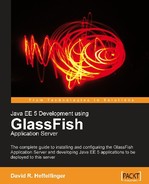Project GlassFish was formally announced at the 2005 JavaOne conference. Version one of the GlassFish application server was released to the public approximately a year later, at the 2006 JavaOne conference. GlassFish version one became the reference implementation for the Java EE 5 specification, and as such, was the first available application server compliant with this specification.
While releasing the first available Java EE 5 application server was a tremendous accomplishment, the first version of GlassFish lacked some enterprise features such as clustering and High Availability. GlassFish version 2, released in September 2007, added these and other enterprise features, in addition to other features such as an enhanced web based administration console.
This book will guide you through the development and deployment of Java EE 5-compliant application on GlassFish version 2. It also covers application development using frameworks that build on top of the Java EE 5 specification, including Facelets, Ajax4jsf, and Seam.
Chapter 1 provides an overview of Glassfish, including how to install it, configure it, and verify the installation.
Chapter 2 covers how to develop server-side web applications using the Servlet API.
Chapter 3 explains how to develop web applications using JavaServer Pages (JSPs), including how to develop and use JSP custom tags.
Chapter 4 discusses how to develop Java EE applications that interact with a relational database system through the Java Persistence API (JPA) and through the Java Database Connectivity API (JDBC).
Chapter 5 explains how to use the JSP Standard Tag Library (JSTL) when developing JavaServer Pages.
Chapter 6 covers how to develop applications using the JavaServer Faces (JSF) component framework to build web applications.
Chapter 7 explains how to develop messaging applications though the Java Messaging Service (JMS) API.
Chapter 8 covers securing J2EE applications through the Java Authentication and Authorization Service (JAAS).
Chapter 9 discusses how to develop Enterprise Java Beans that adhere to the EJB 3 specification.
Chapter 10 explains how to develop and deploy web services that conform to the JAX-WS 2.1 specification.
Chapter 11 covers frameworks that build on top of the Java EE 5 specification, including Seam, Facelets, and Ajax4Jsf.
Appendix A covers sending email from Java EE Applications.
Appendix B covers IDE integration.
This book is aimed at Java developers wishing to become proficient with Java EE 5, who are expected to have some experience with Java and to have developed and deployed applications in the past, but need no previous knowledge of Java EE or J2EE. It teaches the reader how to use GlassFish to develop and deploy applications.
In this book, you will find a number of styles of text that distinguish between different kinds of information. Here are some examples of these styles, and an explanation of their meaning.
There are three styles for code. Code words in text are shown as follows: "We can include other contexts through the use of the include directive."
A block of code will be set as follows:
<head> <meta http-equiv="Content-Type" content="text/html; charset=UTF-8"> <title>Server Date And Time</title> </head>
When we wish to draw your attention to a particular part of a code block, the relevant lines or items will be made bold:
</head>
<body>
<p>Server date and time: <% out.print(new Date()); %></p>
</body>
New terms and important words are introduced in a bold-type font. Words that you see on the screen, in menus or dialog boxes for example, appear in our text like this: "clicking the Next button moves you to the next screen".
Feedback from our readers is always welcome. Let us know what you think about this book, what you liked or may have disliked. Reader feedback is important for us to develop titles that you really get the most out of.
To send us general feedback, simply drop an email to[email protected], making sure to mention the book title in the subject of your message.
If there is a book that you need and would like to see us publish, please send us a note in the SUGGEST A TITLE form on www.packtpub.com or email[email protected].
If there is a topic that you have expertise in and you are interested in either writing or contributing to a book, see our author guide on www.packtpub.com/authors.
Now that you are the proud owner of a Packt book, we have a number of things to help you to get the most from your purchase.
Visit http://www.packtpub.com/support, and select this book from the list of titles to download any example code or extra resources for this book. The files available for download will then be displayed.
The downloadable files contain instructions on how to use them.
Although we have taken every care to ensure the accuracy of our contents, mistakes do happen. If you find a mistake in one of our books—maybe a mistake in text or code—we would be grateful if you would report this to us. By doing this you can save other readers from frustration, and help to improve subsequent versions of this book. If you find any errata, report them by visiting http://www.packtpub.com/support, selecting your book, clicking on the Submit Errata link, and entering the details of your errata. Once your errata are verified, your submission will be accepted and the errata added to the list of existing errata. The existing errata can be viewed by selecting your title from http://www.packtpub.com/support.
You can contact us at[email protected] if you are having a problem with some aspect of the book, and we will do our best to address it.
